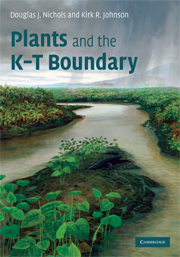Book contents
- Frontmatter
- Contents
- Preface
- PART I BACKGROUND
- 1 Introduction
- 2 Resolution of the K–T boundary
- 3 Using fossil plants to study the K–T boundary
- 4 Brief history of K–T boundary paleobotany and palynology
- 5 Overview of latest Cretaceous and early Paleocene vegetation
- PART II REGIONAL CASE STUDIES
- PART III INTERPRETATIONS
- Appendix
- References
- Index
2 - Resolution of the K–T boundary
Published online by Cambridge University Press: 22 August 2009
- Frontmatter
- Contents
- Preface
- PART I BACKGROUND
- 1 Introduction
- 2 Resolution of the K–T boundary
- 3 Using fossil plants to study the K–T boundary
- 4 Brief history of K–T boundary paleobotany and palynology
- 5 Overview of latest Cretaceous and early Paleocene vegetation
- PART II REGIONAL CASE STUDIES
- PART III INTERPRETATIONS
- Appendix
- References
- Index
Summary
We perceive three increasingly precise scales of temporal resolution of the K–T boundary. Stage-level resolution is on the order of millions of years; subchron-level resolution is on the order of tens to hundreds of thousands of years; and impactite-level resolution, while not directly measurable, is on the order of one to a few years. At the resolution of stage, the boundary between the Cretaceous and Paleogene periods is the boundary between the Maastrichtian Stage (5.1 Ma in duration) and the Danian Stage (3.8 Ma in duration). At the time of the Alvarez discovery, the resolution of most K–T boundary paleontological studies was at the stage level, at best. For most terrestrial K–T sections outside of North America, this level of temporal resolution is still prevalent today. At the subchron level of temporal resolution, the K–T boundary event occurred within the polarity subchron C29r, whose duration was between 570 and 833 thousand years, depending on which calibration is chosen. Resolution at the subchron level often brings recognition of paleontological events to the outcrop scale on the order of tens to hundreds of meters of section. Biostratigraphic zones can have similar durations to subchrons and thus may fall into this category of resolution. The third level of resolution is the impact layer, where physical and biological observations can be directly related to the K–T boundary impactite. At this level, events are resolved at the centimeter, or even millimeter, scale.
- Type
- Chapter
- Information
- Plants and the K-T Boundary , pp. 13 - 26Publisher: Cambridge University PressPrint publication year: 2008



